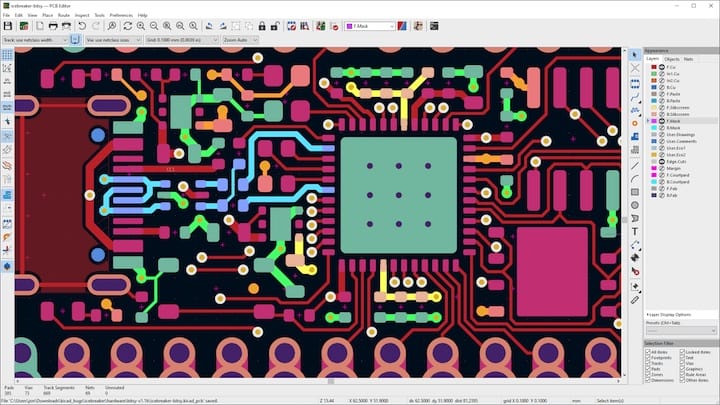How To Install KiCad on Ubuntu 24.04 LTS

KiCad stands as one of the most powerful open-source electronic design automation (EDA) software solutions available today. This comprehensive PCB design suite offers professional-grade capabilities for schematic capture, PCB layout design, and 3D visualization without the hefty price tag of proprietary alternatives. For engineers, hobbyists, and students working on Ubuntu 24.04 LTS, installing KiCad opens up a world of electronic design possibilities.
Ubuntu 24.04 LTS provides an ideal foundation for KiCad development work, offering long-term support until April 2029. This stability ensures your design environment remains consistent and reliable throughout extended project lifecycles. Whether you’re designing simple circuits or complex multi-layer PCBs, this guide will walk you through every installation method available, ensuring you get KiCad running optimally on your Ubuntu system.
System Requirements and Prerequisites
Before diving into the installation process, verifying your system meets KiCad’s requirements ensures smooth operation and optimal performance.
Hardware Requirements
KiCad requires modest hardware specifications but benefits significantly from more powerful systems. The minimum requirements include 1GB RAM, though 2GB or more is strongly recommended for complex designs. You’ll need up to 10GB of available hard disk space for a complete installation with libraries and 3D models.
Your display should support at least 1280×1024 resolution, but 1920×1080 or higher provides the best user experience. Lower resolutions may hide some toolbar buttons, though all functions remain accessible through menus.
Graphics requirements are particularly important for KiCad’s 3D visualization features. Your system needs a graphics card supporting OpenGL 2.1 or greater with hardware shader support. Intel HD2000 and higher models work well, while NVIDIA GeForce FX series and newer GPUs provide excellent performance. Modern AMD Radeon cards also deliver reliable OpenGL support.
System Preparation
Start by updating your Ubuntu 24.04 LTS system to ensure all packages are current. This prevents potential conflicts during installation:
sudo apt update && sudo apt upgradeInstall essential development tools and repository management utilities:
sudo apt install software-properties-commonThis package provides the add-apt-repository command needed for PPA management.
Understanding KiCad Installation Methods
Ubuntu 24.04 LTS offers three primary methods for installing KiCad, each with distinct advantages and use cases.
- The APT PPA method provides the most reliable and frequently updated installation. Official KiCad PPAs deliver the latest stable releases with proper Ubuntu integration. This method offers the best balance of stability and current features.
- Flatpak installation delivers universal packaging with enhanced security through sandboxing. This method ensures consistent behavior across different Linux distributions but may have slightly higher resource usage.
- Snap packages offer automatic updates and easy rollback capabilities. Canonical’s Snap system provides convenient package management, though some users prefer traditional package managers.
Method 1: Installing KiCad via Official PPA (Recommended)
The PPA installation method provides the most straightforward path to the latest KiCad releases. KiCad maintains separate PPAs for each major version series, ensuring clean upgrades and version management.
Adding the KiCad 9.0 PPA
KiCad 9.0 represents the latest stable release with numerous improvements and new features. Add the official PPA repository using this command:
sudo add-apt-repository --yes ppa:kicad/kicad-9.0-releasesThe --yes flag automatically accepts the PPA addition without prompting. This PPA specifically targets the 9.0 release series, providing timely updates and bug fixes.
For users requiring different versions, KiCad maintains individual PPAs:
- KiCad 8.0:
ppa:kicad/kicad-8.0-releases - KiCad 7.0:
ppa:kicad/kicad-7.0-releases - Development builds:
ppa:kicad/kicad-dev-nightly
Updating Package Lists
Refresh your system’s package information to include the new repository:
sudo apt updateThis step ensures Ubuntu recognizes the newly added PPA and can access KiCad packages.
Installing KiCad with Recommended Packages
Execute the complete KiCad installation with all recommended components:
sudo apt install --install-recommends kicadThe --install-recommends flag ensures you receive the complete KiCad suite, including:
- Core KiCad applications
- Standard component libraries
- Footprint libraries
- 3D model packages
- Documentation and examples
This comprehensive installation typically requires 2-3GB of disk space and may take several minutes depending on your internet connection speed.
Verifying PPA Installation
Confirm successful installation by checking the installed version:
kicad --versionThis command displays the KiCad version information, confirming proper installation and PPA integration.
Method 2: Installing KiCad via Flatpak
Flatpak offers a universal packaging solution with enhanced security features and consistent performance across different Linux distributions.
Installing Flatpak Prerequisites
Ubuntu 24.04 LTS typically includes Flatpak support, but verify installation:
sudo apt install flatpakAdding the Flathub Repository
Enable Flathub, the primary source for Flatpak applications:
sudo flatpak remote-add --if-not-exists flathub https://flathub.org/repo/flathub.flatpakrepoThis command safely adds Flathub without duplicating existing configurations.
Installing KiCad via Flatpak
Install KiCad from the Flathub repository:
flatpak install flathub org.kicad.KiCad -yThe -y flag automatically confirms the installation without interactive prompts. Flatpak installations include all necessary dependencies within the package, ensuring consistent operation.
Flatpak-Specific Considerations
Flatpak packages run in sandboxed environments, providing enhanced security but potentially limiting file system access. KiCad may require additional permissions for accessing project files in restricted directories.
Grant necessary file system permissions:
flatpak override org.kicad.KiCad --filesystem=homeThis command allows KiCad to access your home directory for project storage and management.
Method 3: Installing KiCad via Snap
Snap packages provide convenient installation and automatic updates through Canonical’s universal packaging system.
Verifying Snap Installation
Ubuntu 24.04 LTS includes Snap by default, but confirm availability:
sudo apt install snapd -yInstalling Core Snap Components
Install the foundational Snap components:
sudo snap install coreThis ensures all Snap applications function properly within the system environment.
Installing KiCad via Snap
Execute the KiCad Snap installation:
sudo snap install kicadSnap automatically handles dependencies and provides integrated desktop integration.
Managing Snap Permissions
Snap packages may require additional permissions for full functionality. Grant necessary access:
sudo snap connect kicad:removable-mediaThis allows KiCad to access external storage devices for project backup and sharing.
Launching and Initial Configuration
Successfully installed KiCad can be launched through multiple methods depending on your installation approach.
GUI Launch Methods
Access KiCad through Ubuntu’s application menu:
- Click the Show Applications button (grid icon)
- Search for “KiCad” in the application list
- Click the KiCad icon to launch
Alternative desktop integration methods include:
- Dash search: Press Super key and type “KiCad”
- Favorites bar: Pin KiCad for quick access
- Desktop shortcut: Create shortcuts for frequent use
Command Line Launch Options
Different installation methods require specific launch commands:
APT/PPA Installation:
kicadFlatpak Installation:
flatpak run org.kicad.KiCadSnap Installation:
snap run kicad
First-Time Setup and Configuration
KiCad’s initial launch presents the main project manager window. Configure essential settings for optimal workflow:
Library Path Configuration:
Navigate to Preferences → Configure Paths to set up library locations. KiCad automatically configures standard library paths during installation, but custom libraries may require manual specification.
3D Model Path Setup:
Configure 3D model directories under Preferences → Configure Paths → 3D Models. This enables realistic 3D visualization of your PCB designs.
Project Template Configuration:
Set up project templates for consistent design workflows. Templates streamline new project creation with predefined settings and component libraries.
Troubleshooting Common Installation Issues
Even with careful preparation, installation issues may occur. These solutions address the most frequent problems encountered during KiCad installation.
Dependency Conflicts and Resolution
Library Version Conflicts:
If you encounter libocct-visualization errors, remove conflicting packages:
sudo apt autoremove --purge libocct*
sudo apt install --install-recommends kicadBroken Package Scenarios:
Resolve broken packages using:
sudo apt --fix-broken install
sudo dpkg --configure -aHeld Package Issues:
Check for held packages preventing updates:
apt-mark showhold
sudo apt-mark unhold package_namePPA-Related Problems
GPG Key Verification Failures:
Manually import KiCad’s GPG key:
sudo apt-key adv --keyserver keyserver.ubuntu.com --recv-keys [KEY_ID]Repository Priority Conflicts:
Check PPA priorities and adjust if necessary:
sudo nano /etc/apt/preferences.d/kicad-pinMultiple PPA Management:
Remove conflicting PPAs before adding new ones:
sudo add-apt-repository --remove ppa:old-ppa-namePerformance and Graphics Issues
OpenGL Compatibility Problems:
Verify OpenGL support:
glxinfo | grep "OpenGL version"Install missing graphics drivers if OpenGL version is insufficient.
Memory Allocation Issues:
Increase swap space for systems with limited RAM:
sudo fallocate -l 2G /swapfile
sudo chmod 600 /swapfile
sudo mkswap /swapfile
sudo swapon /swapfileSystem Locale Configuration:
Ensure proper locale settings for international compatibility:
sudo dpkg-reconfigure localesMaintaining and Updating KiCad
Regular maintenance ensures optimal KiCad performance and access to the latest features and security updates.
Update Strategies by Installation Method
APT/PPA Updates:
Standard system updates include KiCad:
sudo apt update && sudo apt upgradeFlatpak Updates:
Update all Flatpak applications:
flatpak updateSnap Updates:
Snap packages update automatically, but manual updates are possible:
sudo snap refresh kicadVersion Migration Considerations
When upgrading between major KiCad versions, backup existing projects and configurations. KiCad maintains backward compatibility but may require project file conversions for newer features.
Backup Essential Data:
- Project files and libraries
- Custom footprints and symbols
- User preferences and configurations
- Custom 3D models and packages
Integration with Development Workflows
Version Control Integration:
Configure Git for KiCad projects with appropriate .gitignore files:
# KiCad temporary files
*.bak
*-cache.lib
*-rescue.lib
*.net
*.proCollaborative Design Practices:
Establish team workflows using shared libraries and standardized design rules. KiCad’s library management supports team environments with centralized component databases.
Best Practices for Ubuntu 24.04 LTS
Maximize KiCad’s potential on Ubuntu 24.04 LTS with these optimization strategies.
System Optimization
Memory Management:
Configure appropriate swap settings for large designs. KiCad benefits from generous swap space when working with complex PCBs containing thousands of components.
Storage Optimization:
Use SSD storage for KiCad installation and active projects. The improved I/O performance significantly enhances responsiveness during design work.
Graphics Optimization:
Install proprietary graphics drivers for optimal 3D rendering performance:
sudo ubuntu-drivers autoinstallWorkflow Integration
Documentation Tools:
Integrate KiCad with documentation tools like LibreOffice for comprehensive design documentation. KiCad’s bill of materials export works seamlessly with spreadsheet applications.
Manufacturing Integration:
Configure Gerber file generation settings for your preferred PCB manufacturer. Many manufacturers provide KiCad-specific design rule files for optimal compatibility.
Component Management:
Establish organized component libraries with consistent naming conventions. Well-organized libraries significantly improve design efficiency and reduce errors.
Congratulations! You have successfully installed KiCad. Thanks for using this tutorial for installing the KiCad electronic design automation (EDA) on Ubuntu 24.04 LTS system. For additional help or useful information, we recommend you check the official KiCad website.